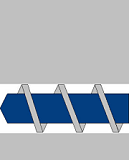The Converting Systems Group of Davis-Standard, LLC recently upgraded and expanded the machinery capabilities at its extrusion pilot lab in Fulton, N.Y., to create one of the nation’s most versatile R&D facilities for converting processes. The lab, equipped with a Black Clawson Converting Machinery (BCCM) coextrusion line, is geared toward multiple applications including cast polypropylene films, stretch wrap, packaging films, flexible packaging and board coating. Customers can take advantage of a system engineered for accuracy, speed and tension control for new product/process development, resin and equipment experimentation and a host of other trial-based and production uses. The line incorporates the latest AC vector drive technology from SSD Drives, and the line’s robotic winder utilizes the latest Allen-Bradley servo drives system for high speed, high torque spindle positioning with accurate position feedback via fiber optic communications.
“This lab is 80 percent dedicated to customer use, so we combined the very best technology to offer a significant amount of versatility,” explained Richard Tetro, vice president of technology for the Converting Systems Group. “In addition to the extruders and winder, we have a range of feedblocks, dies, feedscrews, and testing equipment to accommodate just about every converting process.”
Examples of the line’s high-performance components include a three-extruder coextrusion arrangement with drives and motors, automatic hopper loaders, a resin blender, drying capabilities, a five-layer coextrusion feedblock, casting section/extrusion coater/laminator, multiple nip rolls, a thickness measuring gauge, cooling system, air knife, treater, pivot guide, unwind and scrapless winder. Specific to the winder, customers can evaluate their products over a wide tension range using multiple transfer
methods. The winder also provides the customer the ability to inline slit down to 2-inch (50 mm) widths with or without bleed trims.
The line is controlled by the Integrator PRO process control system. This system provides distributive line control and monitoring of temperature, line drives and winder, while providing historical trending, diagnostics and other data. In addition, more than 30 feedscrews are available to test shear melt points and run various resins. For specific processes, a screw simulation program is available to determine the best screw for the process and resin. Equipment for comparative measurement of inter-layer gauge uniformity in a coextruded construction is also on site.
According to district sales manager, Adnan Bdour, “This system greatly improves our ability to provide customers with more detailed information. This includes items such as torque feedback, speeds and specific faults in a drive. We also have a lot of features for troubleshooting and maintenance to help customers realize added efficiencies.”
In addition to the extrusion pilot lab, a separate large-scale production coating facility, also in Fulton, is available for R&D support, toll coating and small production runs. The BCCM line in this lab now features differential winding and has an operating speed range up to 3,000 feet per minute (900 meters per minute) with web widths up to 40 inches (1,000mm). As with the pilot lab, customers can test formulations, develop and improve new products and evaluate equipment. The two laboratories combined encompass more than 5,000 square feet (464 square meters) of committed R&D space.
For more information about either laboratory, contact Richard Tetro at tetror@bc-egan.com.
